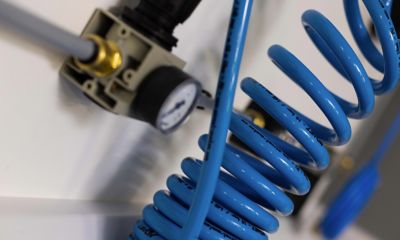Refrigerant dryers work by cooling the compressed air to a temperature where the moisture condenses into water, which is then removed. These dryers are cost-effective and suitable for most applications, providing a pressure dew point (PDP) of around 4°C to 7°C (39.2°F to 44.6°F).
In the world of industrial operations, compressed air is a vital utility. It powers a myriad of tools and processes, from pneumatic machinery to packaging systems. However, the presence of moisture in compressed air can lead to significant problems, including equipment damage and reduced product quality. This blog post delves into the importance of drying compressed air, the risks of not doing so, and the various methods available to achieve dry compressed air.
Understanding Compressed Air
Compressed air is essentially air that has been pressurized to a level higher than atmospheric pressure. It is used in various industries for its versatility and efficiency. However, when air is compressed, the moisture it contains is also compressed, leading to the formation of water vapor. This moisture can cause a range of issues if not properly managed.
What is Compressed Dry Air?
Compressed dry air refers to compressed air that has had most or all of its moisture removed. This type of air is crucial in various applications where moisture can cause damage or inefficiencies. Proper drying techniques and equipment ensure that compressed dry air is achieved to meet industry standards and operational needs.
Key Benefits of Compressed Air Filters
Drying compressed air is crucial for several reasons:
- Preventing Corrosion: Moisture in compressed air can lead to the corrosion of pipes, valves, and other components, reducing their lifespan and efficiency.
- Avoiding Microbial Growth: Wet compressed air can promote the growth of bacteria and mold, which can contaminate products and pose health risks.
- Ensuring Product Quality: In industries like food and beverage, pharmaceuticals, and electronics, the presence of moisture can compromise product quality and safety.
- Reducing Maintenance Costs: Dry compressed air reduces the need for frequent maintenance and repairs, saving time and money.
- Enhancing Equipment Performance: Dry air ensures that pneumatic tools and machinery operate smoothly and efficiently.
Risks of Not Removing Moisture
Failing to remove moisture from compressed air can lead to several issues:
- Corrosion: Moisture can cause rust and corrosion in air compressors and other equipment, leading to costly repairs and replacements.
- Microbial Contamination: Wet air can harbor bacteria and mold, which can contaminate products and pose health risks.
- Reduced Efficiency: Moisture can cause blockages and reduce the efficiency of pneumatic systems, leading to increased energy consumption and operational costs.
- Freeze-Ups: In cold environments, moisture can freeze and block air lines, causing equipment to malfunction.
Types of Drying Equipment
There are several types of drying equipment available to remove moisture from compressed air:
Adsorption dryers use a desiccant material to absorb moisture from the compressed air. These dryers can achieve much lower dew points (from -40°C to -70°C / from -40°F to -94°F), making them ideal for applications requiring extremely dry air.
Selecting the Right Drying Equipment
Choosing the right drying equipment depends on several factors:
- Application: The specific requirements of your application will determine the level of dryness needed.
- Budget: Consider the initial investment and operating costs of the drying equipment.
- Desired Dew Point: The required dew point will influence the type of dryer you need. Lower dew points typically require desiccant dryers, while higher dew points can be achieved with refrigerant dryers.
- Space Constraints: Consider the available space for installing the drying equipment. Refrigerant dryers are generally more compact than desiccant dryers.
Proper Disposal of Condensate
Condensate, the water removed from compressed air, often contains oil particles and other contaminants. Proper disposal of condensate is crucial to avoid environmental fines and reputational damage. Installing oil/water separators and following environmental guidelines can help ensure responsible waste management.
Essential FAQs for Managing Compressed Air Systems
Drying compressed air is essential to prevent issues like corrosion, microbial growth, and reduced production quality that can result from moisture in the air. Properly dried air ensures the longevity of equipment and efficient operations.
Not removing moisture from compressed air can lead to corrosion, microbial contamination, and increased moisture in humid environments, impacting the performance and lifespan of air compressors and other equipment.
Common types of drying equipment for compressed air include refrigerant dryers, which cool down the air to remove moisture, and desiccant dryers, which use a chemical process to eliminate vapor. Each type offers unique benefits and efficiency levels.
The dew point of compressed air indicates the temperature at which water vapor condenses, influencing the level of dryness required for specific applications. Understanding the dew point is crucial in selecting the right drying equipment for optimal air quality.
Condensate contains oil particles released from air compressors, posing environmental risks if not disposed of properly. Following waste disposal guidelines and installing oil/water separators can prevent fines and reputational damage for companies utilizing compressed air systems. By understanding the importance of dry compressed air and implementing the right solutions, industries can ensure efficient, reliable, and high-quality operations.













